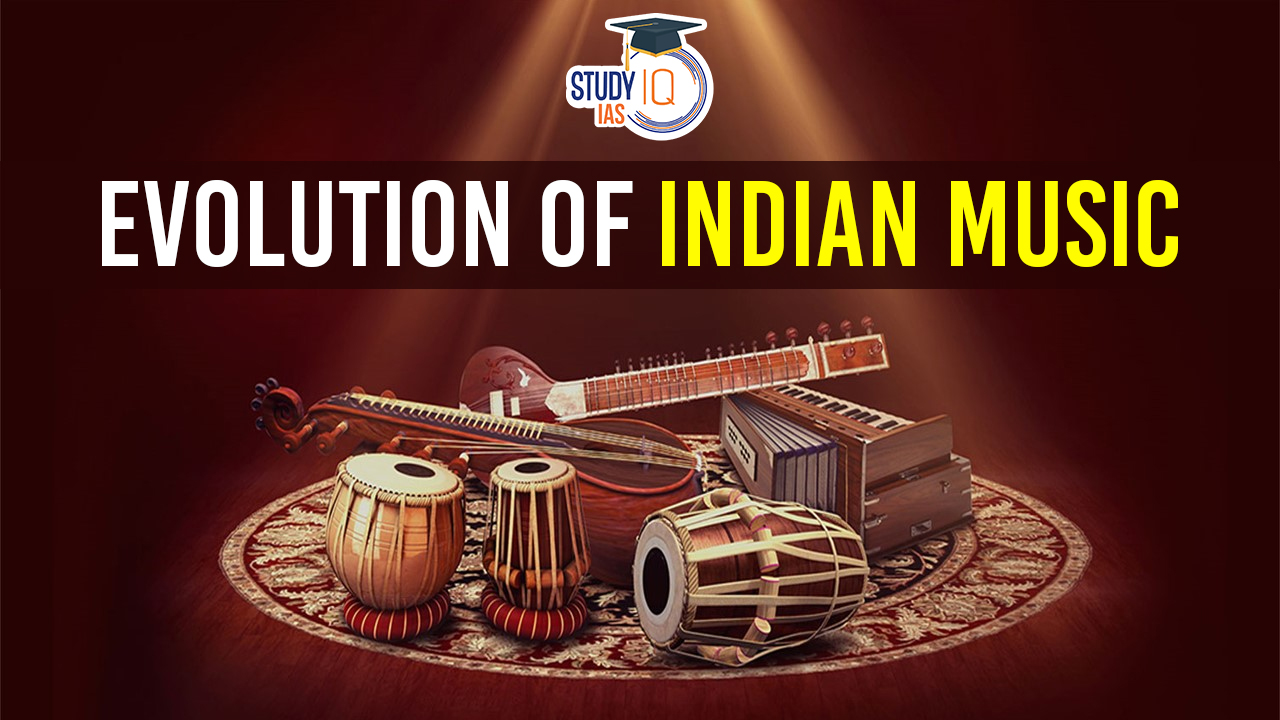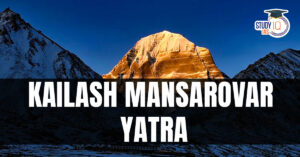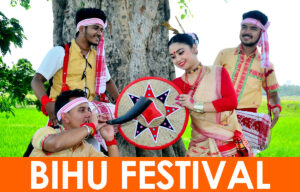Table of Contents
The evolution of Indian music is a rich and complex journey that spans centuries, reflecting the diverse cultural, social, and historical influences of the Indian subcontinent. Indian music can be broadly classified into two main traditions: classical and folk. Each tradition has its own unique characteristics and has evolved over time.
We’re now on WhatsApp. Click to Join
Evolution of Indian Music
Hindustani classical music, rooted in ancient Vedic texts and the Natya Shastra, evolved with contributions from diverse regions and cultures, including Persian and Central Asian influences. The medieval period brought forth classical forms like Dhrupad and Khayal. Carnatic music, directly linked to ancient Indian traditions, developed in the southern regions, with the trinity of Tyagaraja, Muthuswami Dikshitar, and Syama Sastri shaping its repertoire. Both traditions are anchored in melodic ragas and rhythmic talas. India’s folk music, reflecting regional diversity, is influenced by the Bhakti and Sufi movements. Modern times witness the fusion of Western styles and Bollywood’s role in popularizing music, showcasing the dynamic evolution while preserving cultural heritage.
Major Periods in the History of Indian Music
Ancient Period
Origin in Vedic Age:
- The Sama Veda is considered the originator of music among the four Vedas.
- Vedic music began with a single note, gradually evolving to three notes and eventually stabilizing with seven basic notes.
- Vedic hymns were sung and danced during yagas and yagnas, accompanied by string and percussion instruments.
- The concept of Raga had not yet emerged, and group instrument playing was known as ‘kutapa,’ an early form of orchestra.
Development in South India:
- Ilango Adigal, a scholar in the court of Chera Kings, mentioned the development of basic musical ideas by ancient Tamils in the 1st century AD.
- Mahendra Verma (7th century) contributed to Carnatic music by documenting contemporary musical facts in Kudumiyamalai inscriptions.
- Ancient Tamil music represented Ragas with several ‘pans,’ and they were familiar with Sthayi (octave) and well-versed in srutis and the 12 swara sthanas.
Medieval Period
Unified Musical System:
- Until the 13th century, India had a unified musical system based on fundamentals like saptaswaras, octave, and sruti.
- Haripala introduced the terms Hindustani and Karnatak (Carnatic) music for the first time.
- With Muslim rule in the north, Indian music interacted with Arabian and Persian systems, leading to new dimensions.
Bhakti Movement Influence:
- The Bhakti movement from the 7th century produced saint singers and religious teachers, contributing to the development of devotional songs.
- Purandara Dasa, known as ‘Karnataka Sangita Pitamaha,’ reduced the ancient Talas to a system of 35 Talas, influencing the structure of Carnatic music.
- Raga classifications became clearer during this period, laying the foundation for the soul of Indian music.
Modern India – The Golden Period (18th Century)
Musical Development:
- Significant development and activity in musical forms, Ragas, Talas, and musical instruments.
- Scholarly forms like Kritis, Swarajatis, Varna, Pada, Tillana, and Ragamalikas were composed, refining musical and lyrical aspects.
- Notation systems preserved compositions, providing access to invaluable works from the past.
Hindustani Music Systematization:
- Pandit Vishnu Narayan Bhatkhande systematized Hindustani Ragas under the ‘Thaat’ system in the 18th and 19th centuries.
- Composition forms like Khayal, Thumri, and Tarana were introduced.
- Renowned musicians such as Ustad Alladia Khan, Pt. Omkarnath Thakur, and Ustad Bade Gulam Alikhan became legends of the 20th century.
Western Classical Influence:
- Western classical music flourished, with figures like Bach, Hayden, and Beethoven emerging as the “Trinity of Western Music.”
Indian Classical Music
Indian classical music is a rich and intricate tradition with a history that spans centuries. As you mentioned, there are two major schools of Indian classical music: Hindustani and Carnatic.
Hindustani Classical Music
- Geographical Influence: Primarily practiced in the northern parts of India, including states like Uttar Pradesh, Bihar, Rajasthan, Madhya Pradesh, and others.
- Ragas and Talas: Hindustani music is based on the concept of “ragas” (melodic scales) and “talas” (rhythmic cycles). Ragas form the melodic framework, while talas provide the rhythmic structure.
- Instruments: Common instruments used in Hindustani classical music include the sitar, tabla, sarod, santoor, flute, and various percussion instruments.
Carnatic Classical Music
- Geographical Influence: Mainly practiced in the southern parts of India, particularly in states like Tamil Nadu, Karnataka, Andhra Pradesh, and Telangana.
- Ragas and Talas: Similar to Hindustani music, Carnatic music is also based on ragas and talas. However, there are some differences in the way ragas and talas are approached and interpreted.
- Instruments: Key instruments in Carnatic music include the veena, violin, mridangam (a two-headed drum), ghatam (clay pot), and others.
Common Elements
- Ragas and Talas: Both traditions share a common foundation in the use of ragas and talas, but the interpretation and emphasis on certain aspects can vary between the two.
- Improvisation: One of the key features of both Hindustani and Carnatic music is improvisation. Musicians often engage in intricate and spontaneous improvisational elements during performances.
- Spiritual and Cultural Significance: Indian classical music has deep ties to spirituality and cultural traditions. It is often associated with devotion and has been an integral part of various religious practices.
Notable Figures
- Hindustani Music: Ustad Zakir Hussain (tabla), Pandit Ravi Shankar (sitar), Ustad Amjad Ali Khan (sarod).
- Carnatic Music:S. Subbulakshmi (vocal), L. Subramaniam (violin), Palghat Mani Iyer (mridangam).
Both traditions have a vast repertoire of compositions, ranging from slow and meditative to fast-paced and energetic. The learning process involves a close teacher-student relationship, with the oral tradition playing a crucial role in passing down the intricacies of the music from generation to generation.
Indian Folk Music
Indian folk music is a diverse and vibrant form of music that reflects the cultural richness and diversity of different regions in India. Unlike classical music, folk music is often passed down through generations orally and is deeply rooted in the traditions, rituals, and daily lives of various communities. There are numerous folk music traditions across India, each with its unique style, instruments, and themes. Here are some prominent forms of Indian folk music:
- Bihu (Assam): Bihu music is associated with the Bihu festival celebrated in Assam. It includes both dance and music, featuring instruments like dhol, pepa (horn), and gogona (mouth harp). Bihu songs often depict themes of love and nature.
- Baul (West Bengal): The Baul tradition involves itinerant minstrels who sing devotional songs, often expressing the philosophy of seeking the divine within oneself. Baul music is characterized by simplicity and mysticism.
- Rajasthani Folk Music: Rajasthan has a rich tradition of folk music, including forms like Ghoomar, Manganiar, and Kalbelia. Instruments such as the dholak, sarangi, and khartal are commonly used. The songs often narrate tales of valor, love, and daily life.
- Lavani (Maharashtra): Lavani is a traditional dance form from Maharashtra, often accompanied by energetic and rhythmic music. The songs are usually performed in a fast tempo and express a wide range of emotions.
- Bhavageet (Karnataka): Bhavageet is a form of folk music in Karnataka that expresses deep emotions and feelings. The lyrics are often poetic and touch upon themes like love, nature, and the human condition.
- Bhajan (All Over India): While bhajans (devotional songs) are an integral part of various religious traditions across India, they also form a significant part of folk music. Bhajans are often sung in praise of deities and are accompanied by simple instrumentation.
- Pahari (Himachal Pradesh): Pahari folk music from the Himalayan region includes songs related to agricultural activities, seasons, and local festivals. The musical instruments commonly used include the flute, algoza, and damaru.
- Sufi Folk Music: Sufi music, blending elements of mysticism and devotion, is found in various regions of India. Qawwali, a form of Sufi devotional music, is particularly famous, with artists like the Nizami Brothers and Abida Parveen.
- Ghazal (Uttar Pradesh): While ghazal has its roots in Persian poetry, it has become an integral part of North Indian folk music, especially in Uttar Pradesh. Ghazals often express themes of love, loss, and separation.
Indian folk music, with its diversity and regional variations, continues to play a crucial role in preserving cultural heritage and providing a platform for storytelling, celebration, and expression of local identity. It often reflects the daily lives, traditions, and aspirations of the communities that practice and cherish these musical traditions.
Evolution of Indian Music UPSC
The evolution of Indian music spans centuries, encompassing classical and folk traditions. Rooted in Vedic texts, ancient Indian music gradually developed into distinct classical forms like Dhrupad and Khayal in the medieval period. Carnatic music flourished in the south, shaped by Tyagaraja and others. The Bhakti and Sufi movements influenced diverse folk traditions across regions. In the modern era, Western influences and Bollywood fusion showcase dynamic evolution. Hindustani and Carnatic classical music, with their unique ragas and talas, share a spiritual and cultural significance. Indian folk music, diverse and vibrant, reflects local identities, preserving cultural heritage through storytelling and celebration.


 Golconda Blue Diamond, a Rare Gem from I...
Golconda Blue Diamond, a Rare Gem from I...
 Kailash Mansarovar Yatra to Resume Soon,...
Kailash Mansarovar Yatra to Resume Soon,...
 Bihu Festival and Dance of Assam, Histor...
Bihu Festival and Dance of Assam, Histor...





















